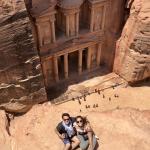Support
During my semester abroad in Spain, I had originally intended to compare the Great Mosque of Córdoba in Spain with the sand castle Quseir Amra in Jordan. Upon my return to SLU in the fall, I would make a print of each of the buildings. In the end, this project allowed me to do hands on research about the interconnectedness of Spain and the Middle East, which is something I have been interested in for quite some time. However, by the end of my semester my project had greatly evolved from my original proposal.
Before going into the semester I knew that Spain was dominated by Arabs for hundreds of years, and therefore had many buildings with Arab influences. I had studied a little bit of the history of the Middle East in high school as well as at SLU, but was unaware of the characteristics of Arab architecture. It wasn’t until I actually arrived in Spain and was taking the History of Spanish art class that I learned all about the architecture in Spain. In this class, we focused on the Roman ruins quite a bit, as well as the Great Mosque of Córdoba, and learned all of the specific details about architectural styles. At this moment, I began to recognize that the Great Mosque of Córdoba not only had Arab influences, but also Roman and Greek influences, similarly to the famous treasury and theater in Petra as well as the Roman Ruins and theater in Amman.
While in Spain, I visited not only the Great Mosque of Córdoba, but also the Roman theater and amphitheater in Mérida, and the cathedral in Seville which was once a mosque. Even between these two vastly different constructions I found quite a bit in common, starting with the columns. Later on in the semester, I traveled to Jordan during a five-day long weekend. At the time, my brother was living in Jordan and became my tour guide for the trip. Throughout my quick stay, we visited Petra, the Roman ruins in Amman, the Wadi Rum desert, the South of Jordan, Quseir Amra and more. The two spots that most pertained to my travel enrichment grant ended up being Petra and Amman. As I stepped out of the valley that lead to the treasury in Petra, I was astounded. Immediately, Spanish architectural vocabulary began to flow through my brain. There were so many more connections than I could’ve ever imagined between Spanish and Jordanian architecture. As I rounded another bend in the valley, I came across the theater. In my mind, I could picture the theater in Mérida that I had seen just weeks before, as well as the one in Amman. The similarities were uncanny, and this is truly when I knew that my project was going to have to change to not just comparing one building in Spain and one in Jordan, but rather to analyzing many different buildings in both countries. Ultimately, I decided on making prints on the Great Mosque of Córdoba and the treasury in Petra because I thought that these two vastly different structures still had many profound similarities, and are both historic landmarks for their respective countries.
By the end of the semester, I had explored many parts of both Spain and Jordan, which was something I never knew would be possible during my time in college. It was thanks to the Cabot Family Endowment for International and Intercultural Education that my dreams became a reality. Although I am still unsure of what my Senior Year Experience (SYE) will be, I may focus on the Umayyad dynasty's influences in Spain, which would directly correlate to my travel grant. Overall, this experiential learning helped me grow academically, artistically, and culturally, and I will remember these experiences for the rest of my life.
